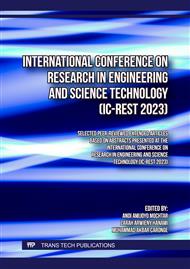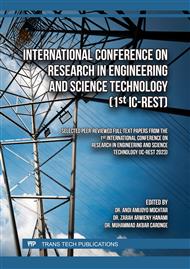p.35
p.43
p.53
p.61
p.69
p.75
p.85
p.93
p.103
Effects of Adding Passive Mass and Varying Cutting Angles of Carbide Chisels with Cutting Oblique in AISI 1045 Steel Turning
Abstract:
In the era of the manufacturing industry which is developing very rapidly, a manufactured product must have high product quality, especially machining products such as turning products. AISI 1045 steel is a type of low carbon steel with a carbon content of (0.43% – 0.50%) which is often used on the market because it has many advantages and the price is quite affordable. Vibrations that occur in the turning process cause undesirable effects; such as discomfort, inaccuracies in measurements and non-optimal turning results. Roughness really depends on the type of tool and tool geometry. In this study, carbide chisels were used with cutting variations, namely: variations in cutting angle (Kr) selected 800, 850 and 900, spindle rotation (n) 200 rpm, feeding (f) 0.3 mm/put , feeding depth (a) 1 mm and load mass (m) 150 grams, 300 grams and 450 grams. When turning, the amplitude value is measured using the Vibxpert toolII and After turning each set of machining variables, the roughness is measured using a machine Laser 3D Measuring Laser Microscope OLS4100. The measurement data obtained is graphed with the relationship of Load Mass & cut angle with roughness and amplitude value. The purpose of this research is to find out the effect of passive mass reduction and the cutting angle of AISI 1045 Steel on the roughness and amplitude values. From the results of the analysis, it was found that the most optimal load mass is 450 grams and the cutting angle (Kr) the most optimal is 80° with a roughness value of 4.07 µm and an amplitude value of 0.15 mm/s2.
Info:
Periodical:
Pages:
69-74
Citation:
Online since:
March 2025
Authors:
Price:
Сopyright:
© 2025 Trans Tech Publications Ltd. All Rights Reserved
Share:
Citation:



